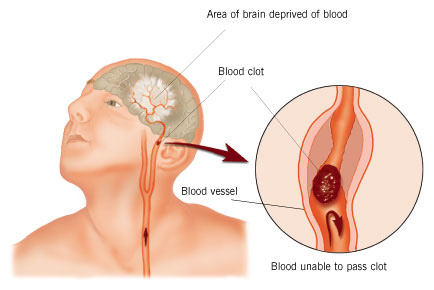
What is a Stroke?
A stroke is a cerebrovascular accident also known as "Brain Attack" where part of a brain rundowns of Oxygen. This needs an urgent medical assistance as this is caused due to a damaged artery which supplies oxygen to the brain , this damage may be due to many reasons .
One have to keep in mind that brain cells die within minutes without oxygen , the more brain goes without oxygen the worst and permanent the impact would be as the death of the brain cells would let the accumulation of toxic substances or chemicals , so a medical assistance must be provided with in minutes .
Potential damage from a stroke includes paralysis, impaired speech, memory loss, coma, or death. Prompt treatment improves the chances for survival and decreases the risk of brain damage.
Worldwide, there are 15 million strokes a year. Of those, a third die and another third are permanently disabled. But a high gratitude should be given to Science , or the Medical Technologies for saving a few from Strokes.
One have to keep in mind that brain cells die within minutes without oxygen , the more brain goes without oxygen the worst and permanent the impact would be as the death of the brain cells would let the accumulation of toxic substances or chemicals , so a medical assistance must be provided with in minutes .
Potential damage from a stroke includes paralysis, impaired speech, memory loss, coma, or death. Prompt treatment improves the chances for survival and decreases the risk of brain damage.
Worldwide, there are 15 million strokes a year. Of those, a third die and another third are permanently disabled. But a high gratitude should be given to Science , or the Medical Technologies for saving a few from Strokes.
Types of Strokes
A stroke is categorized by the nature of the blockage and where it originates. Two main categories of strokes are ischemic and hemorrhagic.
Ischemic Strokes
Clots form in arteries and block blood flow in a process called ischemia, and there are two types of ischemic strokes. When a clot originates in the brain and blocks blood flow, it is called a thrombotic stroke. A clot can also form in another part of the body, such as the arm or heart, and then travel through blood vessels and get lodged in the brain. This is called an embolic stroke. The two most common ischemic strokes—which account for about 75 percent of all strokes—are as follows:
Other categories of ischemic strokes include strokes caused by blood clots formed in the heart (often caused by irregular heartbeat, heart attack, or abnormalities of the heart valves), those caused by blood clotting disorders, and those caused by traumatic injury to the blood vessels in the neck. Overall, clots are responsible for about 90 percent of all strokes.
Hemorrhagic Strokes
A stroke can also occur when a blood vessel breaks or bursts, known as a hemorrhage. The two most common types of hemorrhagic strokes are as follows:
Preventing in sense it does not evolve in a single day and keep you fit , be conscience with what you eat and that would be a giant leap towards protecting your heart .
Preventing a stroke is all about taking care of your heart and your blood. This means keeping your good cholesterol high, and your bad cholesterol low with diet , exercise, and avoiding some specific bad habits. Here are some ways to lower your risks for stroke:
Check out Bad V/s Good Cholesterol for better awareness
As cholesterol can directly impact your likelihood of having a stroke, keeping your cholesterol in check can help you fight off stroke and other cardiovascular problems. A diet rich in fiber, whole grains, fresh fruits, and lots of vegetables can help reduce your risk. Avoiding foods that are processed, high in cholesterol, high in saturated fat, and loaded with sodium can also help you avoid a stroke, among other health problems.
Exercise
Thirty minutes of exercise a day can do wonders for your body. Raising your heart rate while exercising helps the body clear toxins and can help strengthen your heart, blood vessels, and brain. Consult your doctor before starting any exercise regimen to ensure you don’t do more harm that good.
Mind Your Blood Pressure
Blood pressure is a major factor in your risk of of having a stroke. Working with your doctor early can help keep your blood pressure at the appropriate levels. Avoiding sodium and getting some regular exercise can help significantly. Also, try to eat a diet that is high in fruit, vegetables, and potassium; these have all been shown to significantly decrease blood pressure.
Don’t Smoke
Among the many health problems caused by smoking, an increased risk of stroke is certainly one of the most serious. The poisons in cigarette smoke constrict, and contribute to hardening of the blood vessels, which increases the likelihood that clots will form and stroke will occur.
Limit Alcohol
Alcohol is a double-edged sword for stroke as it can both increase and decrease risk of stroke. The key is moderation: Small amounts of alcohol can increase your good cholesterol levels, which, in turn, lowers the bad cholesterol that increases risk of blood clotting and stroke. Excessive amounts of alcohol, however, can damage your heart and blood vessels.
Control Chronic Conditions
If you suffer from high cholesterol, high blood pressure, obesity, or diabetes, then the more you actively manage your condition, the better chance you have of avoiding a stroke.
No comments:
Post a Comment